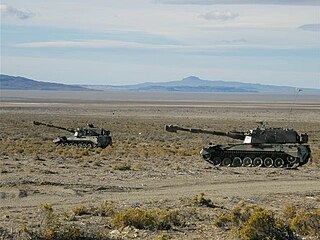
An anti-aircraft vehicle, also known as a self-propelled anti-aircraft gun (SPAAG) or self-propelled air defense system (SPAD), is a mobile vehicle with a dedicated anti-aircraft capability.

The ZSU-57-2 Ob'yekt 500 is a Soviet self-propelled anti-aircraft gun (SPAAG), armed with two 57 mm autocannons. 'ZSU' stands for Zenitnaya Samokhodnaya Ustanovka, meaning "anti-aircraft self-propelled mount", '57' stands for the bore of the armament in millimetres and '2' stands for the number of gun barrels. It was the first Soviet mass-produced tracked SPAAG after World War II. In the USSR, it had the unofficial nickname Sparka, meaning "twin mount," referring to the twin autocannon with which the vehicle is armed.
OTO Melara was a subsidiary of the Italian company Finmeccanica, today Leonardo, active in the defence sector, with factories in Brescia and La Spezia.

The OTO Melara 76 mm gun, marketed as the OTO 76/62 Gun Mount, is a naval autocannon built and designed by the Italian defence company OTO Melara. It is based on the OTO Melara 76/62C and evolved toward 76/62 SR and 76/62 Strales.

The Oerlikon GDF or Oerlikon 35 mm twin cannon is a towed anti-aircraft gun made by Oerlikon Contraves. The system was originally designated 2 ZLA/353 ML but this was later changed to GDF-001. It was developed in the late 1950s and is used by around 30 countries.

The Centauro is a family of Italian military vehicles originating from a wheeled tank destroyer for light to medium territorial defense and tactical reconnaissance. It was developed by a consortium of manufacturers, the Società Consortile Iveco Fiat - OTO Melara (CIO). Iveco Fiat was tasked with developing the hull and propulsion systems while Oto Melara was responsible for developing the turrets and weapon systems.
The Juche-po (M1992) is a North Korean self-propelled artillery gun, based on a modified Ch'ŏnma-ho chassis.

The Audace-class destroyers were two guided missile destroyers built for the Italian Navy during the Cold War. An improvement of the Impavido class, these ships were designed for area air defence and also had a heavy gun armament. They were fitted with contemporary American radars and sonars, but also, as the next Italian ships, all the modern weapons made by Italian industry of the time, such torpedoes, helicopters and guns. Also some indigenous radars were fitted.

The Durand de la Penne class are two guided-missile destroyers operated by the Italian Navy. The design is an enlarged version of the Audace class, updated with diesel and gas turbine CODOG machinery and modern sensors. Four ships were planned but the second pair were cancelled when Italy joined the Horizon project.

Counter rocket, artillery, and mortar, abbreviated C-RAM or counter-RAM, is a set of systems used to detect and/or destroy incoming rockets, artillery, and mortars before they hit their targets, or provide early warning.

Marksman is a British short range air defense system developed by Marconi, consisting of a turret, a Marconi Series 400 radar and two Swiss Oerlikon 35 mm anti-aircraft autocannons. It is similar to the German Gepard system in terms of engine performance, ammunition carried and effective range of the ammunition.

The Type 95 is a Chinese self-propelled anti-aircraft vehicle. It is armed with four 25 mm caliber cannons and optionally four fire-and-forget QW-2 infrared homing missiles. It was first displayed publicly at the Beijing Military Parade in 1999. Earlier in development the system was designated Type 90-II and Type 90-III.

The Palmaria is an Italian self-propelled howitzer using the 155 mm (6.1″) NATO-standard artillery calibre.

ZSU-37 was a Soviet-made, light, self-propelled anti-aircraft gun (SPAAG), developed by the end of 1943 and produced at Works No. 40 in Mytishchi. It was the first Soviet series-produced tracked SPAAG. ZSU stands for Zenitnaya Samokhodnaya Ustanovka, meaning "anti-aircraft self-propelled mount".

The OF-40 is an Italian main battle tank developed as a joint venture between OTO Melara and Fiat, and intended primarily for export sales. OTO Melara would develop and produce the hulls, and automotive components would be provided by Fiat. Initial design work was started by OTO Melara in 1977, with the first prototypes ready by 1980.

The SPG Kalina is a heavy, multi-purpose armoured personnel carrier designed at the OBRUM and is produced by the Bumar Łabędy company - part of Polish military consortium - Bumar Group. SPG is a development of the joint Poland, Soviet Union and East Germany transporter called MT-S, developed in the late 1980s.

The ZSU-23-4 "Shilka" is a lightly armored Soviet self-propelled, radar-guided anti-aircraft weapon system (SPAAG). It was superseded by the 2K22 Tunguska.

The VBM – Freccia is a family of 8x8 armoured vehicles that was designed and manufactured for the Italian Army by IVECO for the hull, the engine and the suspension, and OTO Melara for the armament. The first variant to be developed was the IFV, the Freccia being equipped with a Hitfist turret, the same as the one installed on the Dardo IFV.

The Type 08 is a Chinese family of modern eight-wheeled, amphibious, modular armored vehicles developed by Norinco for infantry fire support, battlefield logistics, and quick reaction operations. Developed in the early 2000s, the vehicle family were produced for more than 6,000 hulls and widely deployed by the People's Liberation Army Ground Force and People's Liberation Army Marine Corps.

The Skyranger 35 is a short range air defence turret system developed by Rheinmetall Air Defence AG.


















